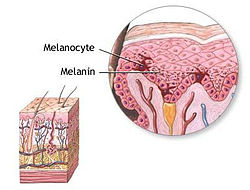- Melanocyte
-
Melanocyte 
Melanocyte and melanin. Latin melanocytus MeSH Melanocytes Code TH H2.00.03.0.01016 Melanocytes
 i/mɛˈlænɵsaɪt/ are melanin-producing cells located in the bottom layer (the stratum basale) of the skin's epidermis, the middle layer of the eye (the uvea),[1] the inner ear,[2] meninges,[3] bones,[4] and heart.[5] Melanin is a pigment that is responsible primarily for the color of skin.
i/mɛˈlænɵsaɪt/ are melanin-producing cells located in the bottom layer (the stratum basale) of the skin's epidermis, the middle layer of the eye (the uvea),[1] the inner ear,[2] meninges,[3] bones,[4] and heart.[5] Melanin is a pigment that is responsible primarily for the color of skin.Contents
Melanogenesis
Through a process called melanogenesis, these cells produce melanin, which is a pigment found in the skin, eyes, and hair. This melanogenesis leads to a long-lasting tan, which is in contrast to the tan that originates from oxidation of already-existing melanin.[6]
There are both basal and activated levels of melanogenesis; in general, lighter-skinned people have low basal levels of melanogenesis. Exposure to UV-B radiation causes an increased melanogenesis as a response to DNA photodamage.[7]
Since the action spectrum of sunburn and melanogenesis are virtually identical, it is assumed that they are induced by the same mechanism.[8] The agreement of the action spectrum with the absorption spectrum of DNA points towards the formation of cyclobutane pyrimidine dimers (direct DNA damage). The initialism for cyclobutane pyrimidine dimers is CPDs.
Human differences
There are typically between 1000 and 2000 melanocytes per square millimeter of skin. Melanocytes comprise from 5% to 10% of the cells in the basal layer of epidermis. Although their size can vary, melanocytes are typically 7 micrometres in length.
The difference in skin color between lightly and darkly pigmented individuals is due not to the number (quantity) of melanocytes in their skin but to the melanocytes' level of activity (quantity and relative amounts of eumelanin and pheomelanin). This process is under hormonal control, including the MSH and ACTH peptides that are produced from the precursor proopiomelanocortin.
Albinos lack an enzyme called tyrosinase[dubious ]. Tyrosinase is required for melanocytes to produce melanin from the amino acid tyrosine.
Stimulations
Numerous stimuli are able to alter melanogenesis, or the production of melanin by cultured melanocytes, although the method by which it works is not fully understood. Melanocortins have been discussed to have effect on appetite and sexual activity in mice.[9] Vitamin D metabolites, retinoids, melanocyte-stimulating hormone, forskolin, cholera toxin, isobutylmethylxanthine, diacylglycerol analogues, and UV irradiation all trigger melanogenesis and, in turn, pigmentation. Also producing chronic diseases when UV Rays hit open sores.[10] The production of melanin is also initiated by ACTH (an adrenocorticotropic hormone).[citation needed]
Once made, melanin is moved along arm-like structures called dendrites in a special container called a melanosome, which is shipped to the keratinocytes. Melanosomes are vesicles or packages of the chemical inside a plasma membrane. The melanin is in organelles called "melanosomes", which are organized as a cap protecting the nucleus of the keratinocyte.
When ultraviolet rays penetrate the skin and damage DNA, thymidine dinucleotide (pTpT) fragments from damaged DNA will trigger melanogenesis[11] and cause the melanocyte to produce melanosomes, which are then transferred by dendrite to the top layer of keratinocytes.
See also
- Chromatophore (the pigment cell type found in poikilotherm animals)
- Eye color
- Follicular melanocyte
- List of human hair color genes
- Melanocytic tumors of uncertain malignant potential
- Melanoma
- Mole (skin marking)
- Nevus depigmentosus
- Tanning activator
- Vitiligo
References
- ^ Barden H and Levine S (1983). "Histochemical observations on rodent brain melanin". Brain Research Bulletin 10 (6): 847–851. doi:10.1016/0361-9230(83)90218-6. PMID 6616275.
- ^ Markert CL and Silvers WK (1956). "The effects of genotype and cell environment on melanoblast differentiation in the house mouse". Genetics 41 (3): 429–450. PMC 1209793. PMID 17247639. http://www.pubmedcentral.nih.gov/articlerender.fcgi?tool=pmcentrez&artid=1209793.
- ^ Mintz B (1971). "Clonal basis of mammalian differentiation". Symposia of the Society for Experimental Biology 25: 345–370. PMID 4940552.
- ^ Nichols SE and Reams WM (1969). "The occurrence and morphogenesis of melanocytes in the connective tissues of the PET/MCV mouse strain". Journal of Embryology and Experimental Morphology 8: 24–32. PMID 14426921.
- ^ Theriault LL and Hurley LS (1970). "Ultrastructure of developing melanosomes in C57 black and pallid mice". Developmental Biology 23 (2): 261–275. doi:10.1016/0012-1606(70)90098-9. PMID 5476812.
- ^ tanning tips
- ^ Agar N and Young AR (2005). "Melanogenesis: a photoprotective response to DNA damage?". Mutation Research 571 (1–2): 121–32. doi:10.1016/j.mrfmmm.2004.11.016. PMID 15748643.
- ^ Parrish JA, Jaenicke KF and Anderson RR (1982). "Erythema And Melanogenesis Action Spectra Of Normal Human Skin". Photochemistry and Photobiology 36 (2): 187–191. doi:10.1111/j.1751-1097.1982.tb04362.x. PMID 7122713.
- ^ Thompson C and Berger A (2000). "Agent provocateur pursues happiness". BMJ 321 (7252): 12. doi:10.1136/bmj.321.7252.12. PMC 1127681. PMID 10875824. http://www.pubmedcentral.nih.gov/articlerender.fcgi?tool=pmcentrez&artid=1127681.
- ^ Roméro-Graillet C, Aberdam E, Biagoli N, Massabni W, Ortonne JP and Ballotti R (1996). "Ultraviolet B radiation acts through the nitric oxide and cGMP signal transduction pathway to stimulate melanogenesis in human melanocytes". Journal of Biological Chemistry 271 (45): 28052–6. doi:10.1074/jbc.271.45.28052. PMID 8910416.
- ^ Eller MS, Maeda T, Magnoni C, Atwal D and Gilchrest BA (1997). "Enhancement of DNA repair in human skin cells by thymidine dinucleotides: evidence for a p53-mediated mammalian SOS response". Proceedings of the National Academy of Sciences of the United States of America 94 (23): 12627–32. doi:10.1073/pnas.94.23.12627. PMC 25061. PMID 9356500. http://www.pubmedcentral.nih.gov/articlerender.fcgi?tool=pmcentrez&artid=25061.
Further reading
- Ito S (2003). "The IFPCS presidential lecture: a chemist's view of melanogenesis". Pigment Cell Research 16 (3): 230–6. doi:10.1034/j.1600-0749.2003.00037.x. PMID 12753395.
- Millington GW (2006). "Proopiomelanocortin (POMC): the cutaneous roles of its melanocortin products and receptors". Clinical and Experimental Dermatology 31 (3): 407–12. doi:10.1111/j.1365-2230.2006.02128.x. PMID 16681590.
External links
- Melanocyte at eMedicine Dictionary
- Histology at BU 07903loa - "Eye: fovea, RPE"
- Histology at BU 08103loa - "Integument: pigmented skin"
Human cell types / list derived primarily from ectoderm Surface ectoderm Neural crest Digestive systemNeural tube Categories:- Human cells
- Pigment cells
- Skin anatomy
Wikimedia Foundation. 2010.
